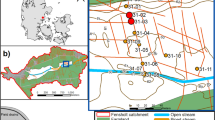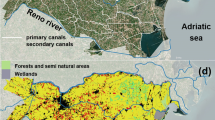Abstract
Denitrification in floodplains is a major issue for river- and groundwater quality. In the Upper Rhine valley, floodplain forests are about to be restored to serve as flood retention areas (polders). Besides flood attenuation in downstream areas, improvement of water quality became recently a major goal for polder construction. Redox potential monitoring was suggested as a means to support assessment of nitrogen elimination in future floodplains by denitrification during controlled flooding. To elucidate the relationship between redox potential and denitrification, experiments with floodplain soils and in situ measurements were done. Floodplain soil of two depth profiles from a hardwood forest of the Upper Rhine valley was incubated anaerobically with continuous nitrate supply. Reduction of nitrate was followed and compared with redox potential and organic matter content. The redox potential under denitrifying conditions ranged from 10 to 300 mV. Redox potential values decreased with increasing nitrate reduction rates and increasing organic matter content. Furthermore, a narrow correlation between organic matter and nitrate reduction was observed. Experiments were intended to help interpreting redox potentials generated under in situ conditions as exemplified by in situ observations for the year 1999. Results obtained by experiments and in situ observations showed that monitoring of redox potential could support management of the flooding regime to optimize nitrogen retention by denitrification in future flood retention areas.
Similar content being viewed by others
References
Culbertson, C. W., A. J. B. Zehnder & R. S. Oremland, 1981. Anaerobic oxidation of acetylene by estuarine sediments and enrichment cultures. Apl. envir. Microbiol. 41: 396–403.
Ball, D. F., 1964. Loss on ignition as an estimate of organic matter and organic carbon in non-calcareous soils. J. Soil Sci. 15: 84–92.
Behrendt, H., 1999. Nährstoffbilanzen der Flußgebiete Deutschlands. Texte, UBA 75/99, Berlin.
Brettar, I. & G. Rheinheimer, 1992. Influence of carbon availability on denitrification in the central Baltic Sea. Limnol. Oceanogr. 37: 1146–1163.
Brettar, I., J. M. Sanchez-Perez, J. Kern, M. Trémolières & H. Rennenberg, 1998. Stickstoffretention in Auenwäldern des Oberrheins. Deutsche Gesellschaft für Limnologie, Tagungsberichte, Krefeld: 647–651.
Brettar, I., J. M. Sanchez-Perez & M. Trémolières, 2000. Auen und Polder als Stickstoffsenken: Redoxdynamik in Auenwaldböden des Oberrheins. Deutsche Gesellschaft für Limnologie, Tagungsberichte, Tutzing: 439–443.
Brinson, M. M., H. D. Bradshaw & E. S. Kane, 1984. Nutrient assimilative capacity of an alluvial floodplain swamp. J. appl. Ecol. 21: 1041–1057.
Caraco, N. & J. J. Cole, 1999. Human impact on nitrate export: an analysis using major world rivers. Ambio 28: 167–170.
Davies, B. E., 1974. Loss on ignition as an estimate of soil organic matter. Soil Sci. Soc. am. Proc. 38: 150–151.
DeLaune, R. D., R. R. Boar, C.W. Lindau & B. A. Kleiss, 1996. Denitrification in bottomland hardwood wetland soils of the Cache River. Wetlands 16: 309–320.
Dister, E., 1991. La maîtrise des crues par la renaturation des plaines alluviales du Rhin supérieur. Bull. Soc. Industr. Mulhouse 824: 73–82.
Faulkner, S. P., W. H. Patrick & R. P. Gambrell, 1989. Field techniques for measuring wetland soil parameters. Soil Sci. Soc. am. J. 53: 883–890.
Faulkner, S. P. & W. H. Patrick, 1992. Redox processes and diagnostic wetland indicators in bottomland hardwood forests. Soil Sci. Soc. am. J. 56: 856–865.
Grasshoff, K., M. Ehrhardt & K. Kremling, 1983. Methods of Seawater Analysis. Verlag Chemie Weinheim, New York.
Haycock, N. E., G. Pinay & C. Walker, 1993. Nitrogen in river corridors: european perspective. Ambio 22: 340–346.
Lockaby, B. G. & M. R. Wallbridge, 1998. Biogeochemistry. In Messina, M. G. & W. H. Conner (eds), Southern Forested Wetlands: Ecology and Management. Lewis, Boca Raton: 149–172.
Lowrance, R., R. Todd, J. Fail, O. Hendrickson, R. Leonard & L. Asmussen, 1984. Riparian filters as nutrient filters in agricultural watersheds. Bioscience 34: 374–377.
Masscheleyn, P. H, R. D. DeLaune & W. H. Patrick, 1993. Methane and nitrous oxide emissions from laboratory measurements of rice soil suspension: effect of soil oxidation-reduction status. Chemosphere 26: 251–260.
Megonical, J. P., W. H. Patrick & S. P. Faulkner, 1993. Wetland identification in seasonally flooded forest soils. Soil Sci. Soc. am. J. 57: 140–149.
Ministerium für Umwelt und Verkehr Baden—Württemberg, 1996. Rahmenkonzept des Landes Baden—Württemberg zur Umsetzung des Integrierten Rheinprogrammes, Materialien Integriertes Rheinprogramm 7, Stuttgart: 94 pp.
Patrick, W. H., R. P. Gambrell & S. P. Faulkner, 1996. Redox Measurements of Soils. Soil Sci. Soc. Am. & Am. Soc. Agronomy, Methods of Soil Analysis, Part 3. Chemical Methods — SSSA Book Series no. 5, Madison, WI, U.S.A.: 1255–1273.
Peterjohn, W. T. & D. L. Correll, 1984. Nutrient dynamics in an agricultural watershed: observations on the role of a riparian forest. Ecology 65: 1466–1475.
Pezeshki, S. R., 1993. Differences in patterns of photosynthetic responses to hypoxia in flood-tolerant and flood-sensitive tree speciea. Photosynthetica 28: 423–430.
Sanchez-Perez, J. M., 1992. Fonctionnement hydrochimique d'un écosystème forestier inondable de la plaine du Rhin. Ph.D. Thesis, CEREG, Univ. Louis Pasteur, Strasbourg: 176 pp.
Sanchez-Perez, J. M., M. Trémolières, A. Schnitzler, B. Badre & R. Carbiener, 1993. Nutrient content in alluvial soils submitted to flooding in the Rhine alluvial deciduous forest. Acta Oecologica 14: 371–387.
Sanchez-Perez, J. M., M. Trémolières, Y. Grosshans, D. Hartz, R. Hranitsky & P. Killian, 1999. Rôle de la zone non saturée du sol dans le transfert des nitrates vers les eaux souterraines en zone alluviale inondable. 24e journées GFHN, Strasbourg.
Trémolières, M., I. Eglin, U. Roeck & R. Carbiener, 1993. The exchange process between river and groundwater on the central Alsace floodplain (Eastern France). I. The case of the canalised river Rhine. Hydrobiologia 254: 133–148.
Trémolières, M., J. M. Sanchez-Perez, A. Schnitzler & Diane Schmidt, 1998. Impact of river management history on the community structure, species composition and nutrient status in the Rhine alluvial hardwood forest. Plant Ecology 135: 59–78.
Author information
Authors and Affiliations
Rights and permissions
About this article
Cite this article
Brettar, I., Sanchez-Perez, JM. & Trémolières, M. Nitrate elimination by denitrification in hardwood forest soils of the Upper Rhine floodplain – correlation with redox potential and organic matter. Hydrobiologia 469, 11–21 (2002). https://doi.org/10.1023/A:1015527611350
Issue Date:
DOI: https://doi.org/10.1023/A:1015527611350




